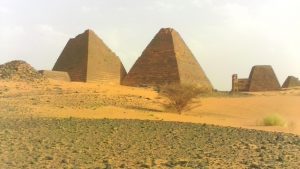
Meroe Pyramids
The physical proportions of Nubian pyramids differ markedly from the Egyptian edifices that influenced them: they are built of stepped courses of horizontally positioned stone blocks and range from approximately six to thirty meters in height, but rise from fairly small foundation footprints that rarely exceed eight meters in width, resulting in tall, narrow structures inclined at approximately seventy degrees. Most also have small Egyptian-inspired offering temple structures abutting their base. By comparison, Egyptian pyramids of similar height generally had foundation footprints that were at least five times larger and were inclined at angles of between forty and fifty degrees.
All of the pyramid tombs of Nubia were plundered in ancient times, but wall reliefs preserved in the tomb chapels reveal that their royal occupants were mummified, covered with jewelry and laid to rest in wooden mummy cases. At the time of their exploration by archaeologists in the nineteenth and twentieth centuries, some pyramids were found to contain the remains of bows, quivers of arrows, archers’ thumb rings, horse harnesses, wooden boxes, furniture, pottery, colored glass, metal vessels, and many other artifacts attesting to extensive Meroitic trade with Egypt and the Hellenistic world.
A pyramid excavated at Meroë included hundreds of heavy items such as large blocks adorned with rock art and 390 stones that comprised the pyramid. A cow buried complete with eye ointment was also unearthed in the area to be flooded by the Meroë Dam, as were musical rocks that were tapped to create a melodic sound.